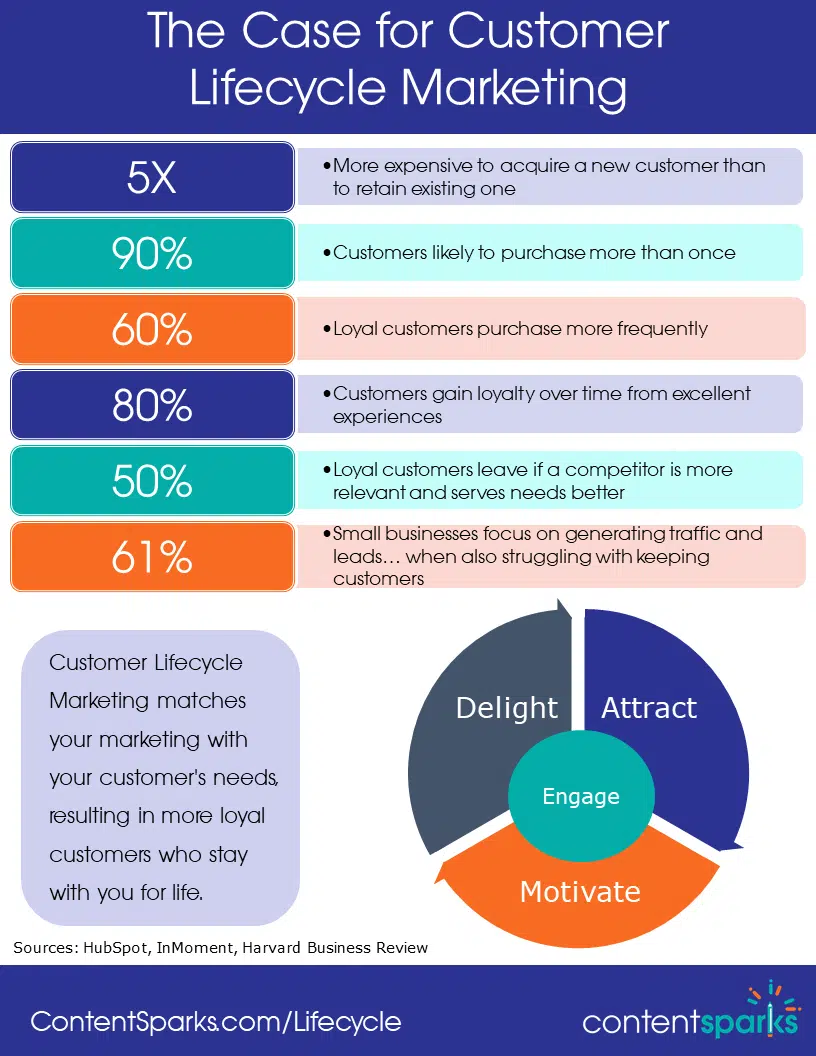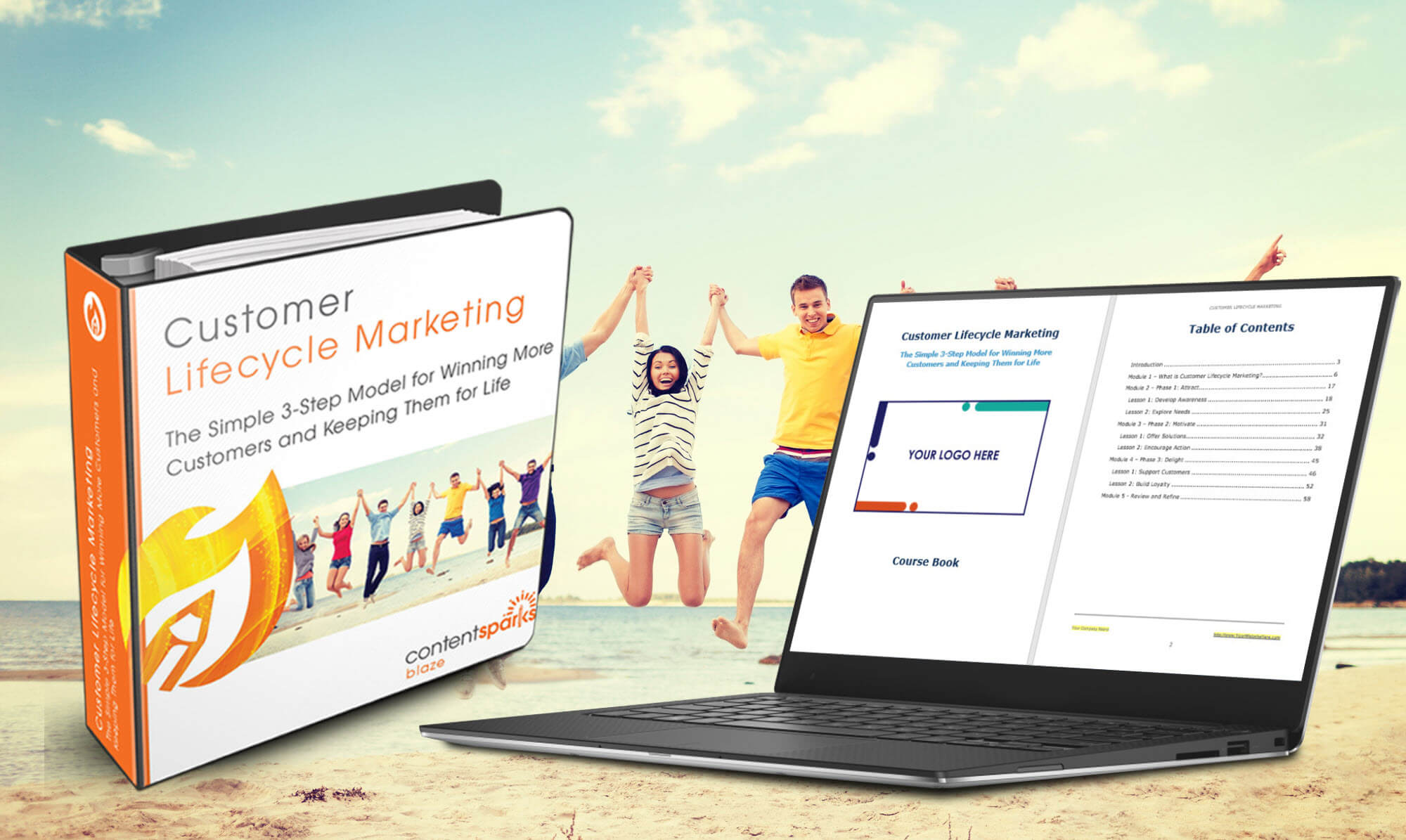Sales funnels are the dinosaurs of marketing.
New business owners used to be told that all they had to do is keep building funnels and the money would follow. And yes, funnels still play a part in your marketing. But it's just a small part in a much larger picture.
When it comes to growing your coaching business, Customer Lifecycle Marketing is the strategy that will lead to GREATER income with LESS expense and effort.
Consider these stats:

Based on those number, it makes sense to focus your time on delivering exceptional products and experiences to your customers,
…before, during, and after they make a purchase.
How Customer Lifecycle Marketing Will Grow Your Coaching Business
Whether you're a business coach or not, the biggest impact the customer lifecycle approach will have is to increase your customer's lifetime value. That's the amount, on average, that each customer contributes to your income, calculated as:
(Average order value) X (Number of orders per year) X (Number of years customers stay) = Lifetime Value of a Customer (LTV)
Now consider how much you spend to acquire a customer, which you can calculate this way:
(Yearly cost of marketing/sales) / Number of customers per year = Cost of Customer Acquisition (CAC)
Your goal in growing your business should be to increase the return you get on your marketing investment. You can figure that out in terms of LTV and CAC by simply dividing one by the other:
LTV / CAC = your return on investment or LTV:CAC ratio.
The problem with concentrating on sales funnels is that they don't take lifetime value of a customer into account. Instead, they look at just the conversions within that single funnel – one sale at a time.
With the Customer Lifecycle Marketing Model, you consider all the sales that come from a customer over their lifetime with you. And as the statistics above show, customers tend to buy more than once if they're happy with what they're receiving.
Here's an example in numbers to show how that plays out for a typical business coach or consultant, where there's one transaction in a sales funnel vs. a lifetime of orders:
Sales Funnel (focusing on selling 1 coaching package offer for $2,000 ):
LTV = $2,000
CAC = $1,000
Ratio = 2:1
Lifecycle Marketing (focusing on selling coaching services + courses + books over several years):
LTV = $20,000
CAC = $4,000 (includes ongoing marketing costs)
Ratio = 5:1
You can see from that example that even though you're continuing to spend on marketing, in order to promote additional services and offers over time, it's still going to be less than what it costs to acquire a brand new client.
That's because your current clients and customers already know you, so you're able to skip a lot of the initial education and brand awareness that can be both costly and time-consuming.
The result? Your income goes up, your coaching business grows, and you spend less time on marketing and more time on things you love!
How to Implement Customer Lifecycle Marketing in Your Coaching Business
Customer Lifecycle Marketing is a holistic approach that matches up with the customer buying experience. It integrates all your marketing tactics and strategies, and considers how you'll keep customers engaged with you and your business over time.
There are 3 phases to the model: Attract, Motivate, and Delight – with Engagement as the driving force that keeps the cycle moving around and around.

Here's a little overview of each phase and some of the tactics you can use as a business coach or consultant:
Phase 1: Attract
Your lifecycle begins with making people aware of who you are and what you offer. That includes existing clients and customers, since they don't always know everything you do. So right away we're deviating from the sales funnel approach, which only focused on brand new prospects.
You also explore needs during this phase, since you're helping people understand their own needs and challenges, and you're giving them mini-solutions to make them aware of how you can help.
Your goal is to attract your ideal clients to the products and services that make most sense for their needs.
What you can do as a business coach to develop awareness and explore needs:
- Have a website spotlighting your services, experience, live appearances, products, etc
- Add a blog to your website and regularly add keyword-optimized content on your core areas of expertise
- Publish content on other public platforms where your target audience can easily find it (video, graphics, slideshows, etc)
- Post regularly on social media where your audience will see, such as in LinkedIn or Facebook Groups (answer questions, share content)
- Create lead magnets for getting people onto your email list
- Schedule an automated email follow-up series and segment based on interest in your topics of expertise
- Offer free training on your core areas of expertise (online and offline), inviting those you know are interested
- Limit the number of free calls or training slots you offer, in order to increase sign-ups
- Send surveys to your subscribers to discover more about their needs
- Use automated chatbots to send your visitors to content relevant to their challenges
- Initiate conversations by asking questions and offering tips and free strategy calls
Phase 2: Motivate
Once you and your prospective clients have a good understanding of their needs, you move into the Motivate phase of the lifecycle.
Here, you offer them different solutions to the needs they became aware of. But at this point, you're not asking questions as much as discussing the features and benefits of the solution that makes most sense for your client.
You also make the purchase process easy and seamless, so they'll take action – following through on your recommendations and buying your offer.
What you can do as a business coach:
- Set up standard packages that meet different levels of client needs (at different price points)
- Run webinars to promote specific offers, giving a little taste, inviting questions, and explaining features and benefits
- Collect case studies from current, happy clients – to include in sales content
- Put together a FAQ page, adding to it as you get more questions over time
- Get creative with guarantees that don't involve money-back, such as additional support IF they've been implementing your recommendations
- Hire a copywriter to help you create or refine your sales page
- Call prospects directly who you think will benefit most from your high-end packages
- Ask a friend to go through your purchase and scheduling process to make sure it's easy and seamless
- Offer add-on resources or services that complement what you're selling (such as a membership site with a course library, or site set-up services)
Phase 3: Delight
Now that you've signed up your paying client, you move into the most important part of keeping them for life. In the Delight phase, you support your clients in implementing their purchase and do all the sorts of things that will lead to repeat buyers and word-of-mouth marketing. That includes tactics like world-class customer support, surveys, community, rewards programs, challenges, etc.
What you can do as a business coach:
- Onboard your new clients with intake forms to get their details, kick-off sessions, more frequent calls at the beginning, screenshare videos to orient them to resources, etc
- Create an automated email sequence for new clients that points them to resources and other FAQs that might come up
- Surprise them with a welcome gift and personal note (could be a resource or even a gift mailed to their house, if appropriate)
- Set up a client-support or mastermind group (especially if it's for group coaching or courses), so people can network, support each other, and you can serve many at once
- Run weekly or monthly customer-only livestream sessions, alternating Q&A with guest speakers or special topics
- Survey customers and clients to see where they need more help and where you can improve. Act on that feedback
- Set up a referral and/or rewards program for clients who recommend you to others
- Encourage clients to give you a recommendation on LinkedIn
The customer lifecycle marketing model doesn't end here. You need to also…
Make sure clients know about other products, courses, and services you offer – as they directly relate to needs you uncover
That will lead them back to awareness as your customers discover new needs and new things you do.
People can also enter the cycle at different points or go back and forth between phases. For example, if someone doesn't buy the first time, you can retarget them or send them more information – going back to the Attract phase. Others might go straight to Motivate if they already know they want something.
Engagement – The Fuel for Your Lifecycle
The key throughout the Customer Lifecycle Marketing Model is Engagement at every step. That's what your customers and clients want and what sets you apart from others in your market.
While many of the tactics I listed in the 3 phases above involve some element of engagement, here's a quick list of strategies you can use to accelerate your engagement with your audience:
What you can do as a business coach:
- Add a question to your surveys about whether you can contact people directly. Then follow-up with a phone call strictly for exploring needs.
- Always have a call to action in your emails that either invites a reply or sends people to a page that involves more action
- Hold local meetups and networking events for your clients and target audience
- Invite clients to join you for coffee when you're at an event in their area
- Run ‘open office hours' in your Facebook Group to answer questions via livestream or comments at set times
- For potential clients who don't buy, offer another option to engage with you – such as an open community where you drop-in regularly
Remember that while engagement fuels the success of your marketing, it doesn't have to be time-intensive. Some engagement strategies, particularly during the ‘Attract' phase, can be automated through chatbots, social media posts, and email to initiate conversations. Then you follow-up and start interacting with people who respond to your overtures.
Have some ideas yet for what YOU can do to shift to a customer lifecycle marketing approach?
I know there are a lot of tactics in this article, but the key is to pick and choose the ones you know you can implement consistently. And pick those that make the most sense for your own target audience.
Want to get started with Customer Lifecycle Marketing?
Download and fill in the Customer Lifecycle Marketing Assessment. Then use our Customer Lifecycle Marketing Plan to outline your plan for taking your marketing into the future:
Want to learn and teach others how to win more customers and keep them for life?
Customer Lifecycle Marketing
Teach Yourself. Then teach your audience.

When you purchase a license to any of our ready-to-go course kits, you get the rights to edit it any way you want (or leave as-is) and add your own name and branding.
Then use your new course to:
- Attract new clients and customers (such as with a free training, webinar, or eCourse)
- Add a new stream of income (such as with a paid course or workshop)
- Keep your current customers successful and coming back for more (such as with bonus webinars, videos, and other learning resources).
Enjoy!

Tags
You may also like
Comments are closed.
Solid article! I’m a marketing consultant and I found several of the points you mentioned were spot on!